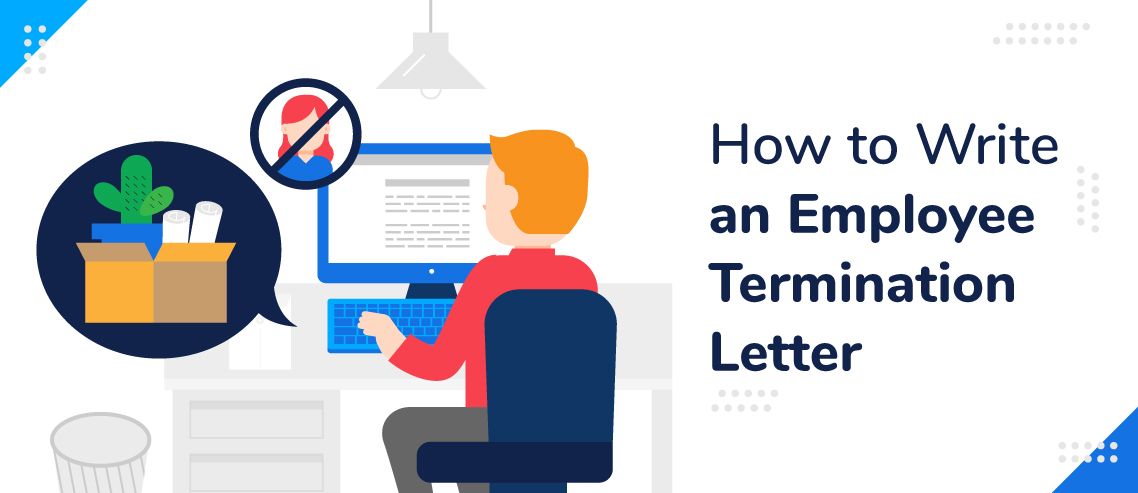How to Write an Employee Termination Letter (with Free Template)

No manager ever wants to have to send a termination letter.
In an ideal world, all employees would perform their duties and responsibilities perfectly, respond well to constructive criticism, and be polite and professional in the workplace.
However, no matter how strong your training or disciplinary procedures, every now and then an employee will behave in a manner that leaves you with no choice but to terminate their employment.
In other situations – such as a company restructure or where there are cash flow issues – the termination of the employment may be a difficult decision that is in no way the fault of the employee.
While firing employees is perhaps the most difficult task a manager must perform during their career, it’s vital to be prepared for such eventualities.
Having a boilerplate termination letter and a watertight process for terminating employment means that such situations can be resolved in as quick and painless a manner as possible.
In addition, having the process and letter approved by all stakeholders – and checked over by your legal team – leaves both you and the company in a much stronger legal position should the employee in question contend their termination.
What is a Termination Letter?
A termination letter is simply the document used to notify – or in some cases confirm to – an employee that their employment contract is to come to an end.
Depending on the situation, the termination letter may be the first time the employee is made aware of the fact that their employment is ending.
In most cases, however, it will be given to them in a meeting, during which the situation is set out verbally. In this case, the letter acts as a formal confirmation of the details and ensures that all parties have a written record of the termination, as well as the reason or reasons behind it.
These reasons can range from performance-related and behavioral issues to restructuring or financial challenges the company is facing. Whatever they are, it’s essential to include them in the letter.
How to Write a Termination Letter
When it comes to writing a termination letter, it’s important to tread carefully. Bear in mind that this document could be used in a court of law should the employee decide to sue.
Firstly, keep the letter’s tone of voice formal. While this may feel like a strange tone of voice to use if, for example, your company culture is very relaxed or your relationship with the employee in question has always been casual, this is a time for formality.
Not only will keeping the tone professional help to ensure you don’t write anything that could work against you in a legal setting, but it shows the employee that this is not a decision that has been taken lightly, and it is being treated with the gravity it deserves.
This sounds obvious, but it really cannot be overstated. Phrase the letter in a way that makes it crystal clear that the individual’s employment is being terminated. Leave no room for confusion whatsoever.
Furthermore, the details of the reason(s) the employment has been terminated should also be laid out in a clear, chronological manner, including details such as dates and times. While you may wish to be concise, it is far more important to include all the details than to get all the information down on one page.
In most cases, the best way forward from the termination letter will be to ensure the employee has as little contact with the company as possible. With this in mind, it’s important to include all the practical information the employee will need about their termination, such as how to collect their belongings from the office, or how to return a work pass.
It’s also essential to include any disciplinary action that has already been taken with regard to the employee in question. This should include verbal warnings, previous written warnings, and suspensions. It is also important to note the details of these disciplinary actions, and set out their consequences.
Wind up the letter with a concluding sentence that makes it clear the decision is an unfortunate one, and a last resort.
What to Include in a Termination Letter + Tips
While termination letters will vary due to differing circumstances, most should include the following elements:
- Your own name, company address, and contact information
- The notification of termination
- The date of termination
- The reasons for the termination
- Details of any disciplinary procedure related to the termination
- Practical information surrounding the recipient’s remaining company-related tasks, such as handing in key fobs, or any handovers required of them
- Information about any benefits or compensation they are entitled to
- A mildly sympathetic closing sentence
Once you’ve written the letter, it’s important that you acquire sign off from all stakeholders involved. It’s also a good idea to run the document past your legal team. This should help to protect you in the case of legal action, and make you feel more confident in handling the situation should the employee react badly.
JD enjoys teaching people how to use ZoomShift to save time spent on scheduling. He’s curious, likes learning new things everyday and playing the guitar (although it’s a work in progress).



